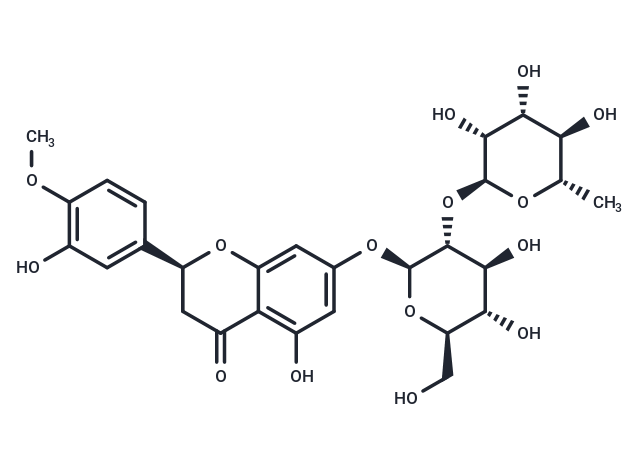Shopping Cart
- Remove All
 Your shopping cart is currently empty
Your shopping cart is currently empty

Neohesperidin (NSC-31048) with antioxidant and neuroprotective properties. Unlike other citrus flavanones, it does not inhibit oral carcinogenesis in a rat model.

| Pack Size | Price | Availability | Quantity |
|---|---|---|---|
| 50 mg | $39 | In Stock | |
| 100 mg | $51 | In Stock | |
| 500 mg | $189 | In Stock | |
| 1 g | $312 | In Stock | |
| 5 g | $713 | In Stock | |
| 1 mL x 10 mM (in DMSO) | $43 | In Stock |
| Description | Neohesperidin (NSC-31048) with antioxidant and neuroprotective properties. Unlike other citrus flavanones, it does not inhibit oral carcinogenesis in a rat model. |
| In vivo | Neohesperidin, administered at a dose of 50 mg/kg, significantly reduces the occurrence of HCl/ethanol-induced gastric lesions by 55.0%. In studies involving pylorus-ligated rats, this compound notably decreases both the volume of gastric secretion and gastric acid output, while simultaneously increasing gastric pH[1]. Additionally, neohesperidin treatment markedly improves glucose metabolism and insulin sensitivity in diabetic mice, evidenced by substantial reductions in fasting glucose, serum glucose, glycosylated serum protein (GSP), serum triglycerides, total cholesterol, and leptin levels, alongside a decrease in the liver index. It also enhances oral glucose tolerance and reduces insulin resistance in these mice[3]. |
| Alias | NSC 31048, Hesperetin 7-O-neohesperidoside |
| Molecular Weight | 610.56 |
| Formula | C28H34O15 |
| Cas No. | 13241-33-3 |
| Smiles | O=C1C=2C(O[C@@H](C1)C3=CC(O)=C(OC)C=C3)=CC(O[C@H]4[C@H](O[C@H]5[C@H](O)[C@H](O)[C@@H](O)[C@H](C)O5)[C@@H](O)[C@H](O)[C@@H](CO)O4)=CC2O |
| Relative Density. | 1.447 g/cm3. Temperature:20 °C.;1.447 g/cm3. Temperature:20 °C. |
| Storage | Powder: -20°C for 3 years | In solvent: -80°C for 1 year | Shipping with blue ice. | ||||||||||||||||||||||||||||||
| Solubility Information | DMSO: 50 mg/mL (81.89 mM), Sonication is recommended. H2O: < 1 mg/mL (insoluble or slightly soluble) Ethanol: < 1 mg/mL (insoluble or slightly soluble) | ||||||||||||||||||||||||||||||
Solution Preparation Table | |||||||||||||||||||||||||||||||
DMSO
| |||||||||||||||||||||||||||||||

Copyright © 2015-2025 TargetMol Chemicals Inc. All Rights Reserved.